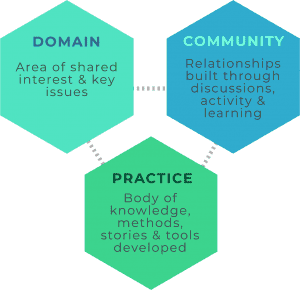Communities of Practice
September 5, 2022
Communities of Practice
Sabeen Rizvi
Open any social media website or app, and you’ll find a slew of ads offering services in further learning and technical practice. Learning outside of formal schooling and creative work are considered solitary processes, spurred forward primarily by lone geniuses. Many people consider this the future of education and knowledge production, as well as knowledge sharing. However, this is not always the case, particularly in places where the most learning and knowledge creation takes place. The most well-known example is that of the scientific world. Scientists are constantly in collaboration with one another, whether on papers, experiments or merely discussion of various concepts. Despite its flaws, science is one of our most powerful tools in conquering modern-day problems. So, it stands to reason that the constant collaboration of scientists is not a hindrance, but the necessary engine of great scientific discoveries (and the vital day-to-day ones). This brings forth the argument that the community-based model may be of use to many fields, not just science. Luckily, that model not only exists but is being furthered through communities of practice.
What is a Community of Practice?
Communities of practice are exactly what the name would suggest, a collection of practitioners coming together to share insights, information and knowledge. Through this sharing, they can brainstorm, problem-solve and accomplish individual or shared goals. This concept was born out of the idea of communities of inquiry, which are more interested in learning and discussing an area of interest to challenge and expand their knowledge, than the more practical aspects of it. In the case of communities of practice, the members of the community are usually in general agreement about the work they are doing. An example would be a group of teachers meeting regularly to discuss new methods of teaching and their students’ challenges and how to address them. A single teacher may struggle with finding a plan that works for students struggle with mathematical concepts, for instance, but a group may find multiple strategies. More so, multiple ‘experiments’ can be shared among individuals, so that results can be found much faster and can be more effectively applied. Communities of practice are now found everywhere, from accounting to design to education to art. Large organizations are also incorporating this concept to allow their employees to innovate collectively and thereby boost productivity.

Why Use a Community of Practice?
Some of the most well-known communities of practice (before the term was even coined) could be said to be artists. The Impressionists, who started one of the most significant movements in art, were one such community. They would meet regularly in cafes, studios and elsewhere in order to discuss their budding movement. They would share techniques, styles, ideas and inspirations with one another, thereby feeding their work. They also encouraged each other to continue with their work, which may have been more difficult alone. Modern psychology and productivity research have both confirmed that systems of accountability and shared goals are far more effective than simply committing to a goal alone. More can also be done this way, as many people can try many approaches for the same idea. This can be further evidenced by the various approaches used in Impressionism to this day, despite it being a shared concept. Art, widely considered the most individualistic and personal of all the fields of human knowledge, still greatly benefits the creation of communities and the sharing of ideas and methods.

What are the Types of Communities of Practice?
If you’re wondering how to join or create a community of practice, there are many ways. The quickest way may be the most recent one, which is virtual communities of practice. There are multiple sites and apps, such as Discord, Reddit, Quora etc. where people with similar interests convene. It is easy to take this a step further and create spaces for practitioners who can share ideas as well. To some extent, this already occurs in many places, even Facebook groups. To take it a step further would be a simple and seamless process. In places where these communities already exist, they can be found through searching online or asking fellow practitioners for recommendations. Physical presence is still considered the ideal, however, due to the concentration and intention it allows, also the lack of technical difficulties found in virtual spaces. This would depend on the number of practitioners in an area, but searching for associations, guilds, organizations or even just groups may be a solid first step for finding them. Then there is the most easily accessible for the large number of us working in organizations, which would be communities of practice within the organization itself. If one exists, you could find out about it through inquiries to colleagues, your supervisor or HR. If not, then you can create your own and add value to your workplace and process.
Though there are many ways to improve at your specific craft or practice, the most consistent and solid way to do so is through engagement with a community. As we have seen in the case of everything from art to science, a group of passionate individuals working together to collectively improve is sure to yield powerful results.
Click to share
Recent Blogs
November 11, 2025
November 3, 2025
October 23, 2025



